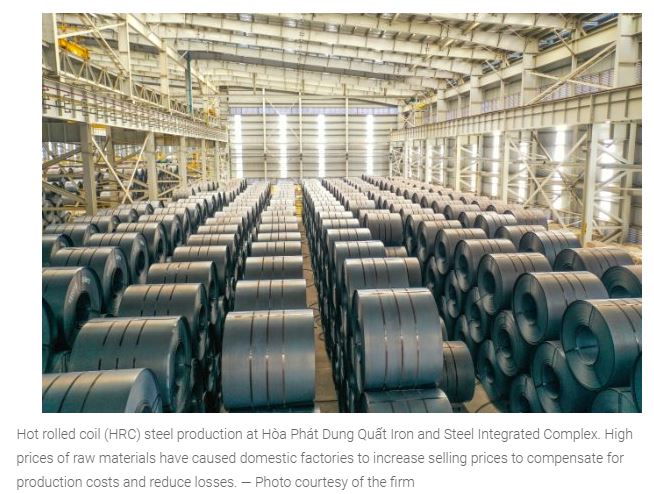Vietnam: Domestic steel enterprises suffer falling demand
In the context of weak domestic steel demand and rising costs pushing up global commodity prices, the selling prices of finished steel are increasing slower than the prices of input materials.
HÀ NỘI — The high prices of raw materials have caused domestic steel companies to increase selling prices many times to compensate for production costs and reduce losses.
In the context of weak domestic steel demand and rising costs pushing up global commodity prices, the selling prices of finished steel are increasing slower than the prices of input materials.
Analysts say that the business performance of construction steel companies is still insignificant.
According to the Việt Nam Steel Association (VSA), steel prices have continuously increased mainly due to the fact that input prices of input materials for steel production such as coal, iron ore, scrap steel, and hot-rolled coils are still climbing.
VSA believes that the high prices of raw materials have caused domestic factories to increase selling prices many times to compensate for production costs and reduce losses.
Since the beginning of the year, steel prices have been continuously adjusted up, with a total increase of more than VNĐ1 million per tonne. Although the upward momentum has slowed down, steel prices will continue to increase in the coming months.
As for steel giant Hoà Phát Group, the analysis team of VNDirect Securities Company said: “With weak demand, Hoà Phát Group may transfer the risk of increasing input material prices to consumers. In addition, low factory operating efficiency in the first half of 2023 will also affect the company’s profit margins, so we forecast Hoà Phát Group’s net profit may be still negative in the first quarter of 2023.”
New data released by the group shows that consumption of steel products in domestic and foreign markets both decreased over the same period. This reflects two different states of the construction market in early 2022 and 2023.
In the first quarter of 2022, construction steel consumption reached a record high thanks to strong growth in market demand. In 2023, the market was quiet due to weak demand, leading to negative steel consumption.
Accumulated in the first 2 months of this year, Hoà Phát Group’s crude steel output reached 809,000 tonnes, down 42 per cent over the same period last year. Sales of construction steel, hot rolled coil (HRC) steel and billet was recorded at 877,000 tonnes, down 34 per cent compared to the first 2 months of 2022.
At the recent 2023 General Meeting of Shareholders of Hoa Sen Group, a representative of this enterprise said that steel exports still saw many potential uncertainties in the context of increasing competition and challenges caused by trade barriers.
Forecasting the market situation in 2023, according to this business, the fierce competition in the domestic market, tightening monetary policies, increasing interest rates, and escalating exchange rates may negatively affect the economy and production of steel companies.
Hoa Sen Group proposed two consumption plans for the financial year 2022-2023.
Under the first plan, the sales volume will reach 1.52 million tonnes, the revenue will be VNĐ34 trillion and the profit after tax will be VNĐ100 billion. In the more positive plan, this enterprise can achieve a sales output of 1.62 million tonnes, revenue of VNĐ36 trillion and profit after tax of VNĐ300 billion.
Previously, according to the report of the fiscal year 2021-2022, the consumption output of Hoa Sen Group reached more than 1.81 million tonnes, completing 91 per cent of the yearly plan; revenue reached VNĐ49.7 trillion, completing 107 per cent of the plan; consolidated profit after tax reached VNĐ251 billion, completing 17 per cent of the plan.
According to the analysis team of VNDirect, the prolonged low demand of the domestic civil construction sector will have a significant impact on the demand for construction materials in 2023. This means that the demand in short term for steel products remains low.
However, the demand for iron and steel is expected to improve thanks to more public investment projects being implemented.
Recently, the Ministry of Transport was assigned by the Government to disburse public investment with a capital of VNĐ94 trillion this year, 1.7 times higher than in 2022.
Other positive signals from the export market, especially recovering demand in China – the largest steel producer and consumer, accounting for more than 50 per cent of total supply and demand in the world – will support domestic steel enterprises.
The research team of DSC Securities said that iron ore prices have witnessed a strong increase of nearly 50 per cent from $85 per tonne to nearly $120 per tonne.
DSC expects demand as well as steel prices to increase further in the second half of 2023. However, the DSC team noted that these recovery signals are still quite weak and likely to be unsustainable.
China had abolished its zero-COVID policy, but it will still take a certain amount of time to really restart the economy. According to DSC, FDI growth and public investment are also not certain factors. When the supporting factors have not been put into practice, steel prices may end up gaining momentum due to high expectations and enter a correction span.
However, last week, steel stocks still recorded gains in the context that the steel industry is expected to recover thanks to the government’s boost in public investment and recovery in demand in China.
Accordingly, Nam Kim Group (NKG) increased by 8.8 per cent, Hoa Sen Group (HSG) rose by 7.2 per cent and Hoà Phát Group (HPG) gained by 4.7 per cent. VNS


 Thailand
Thailand




